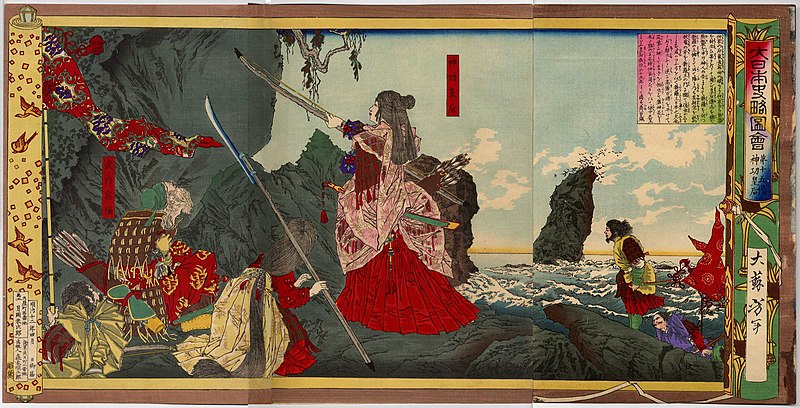
The Legendary Empress Jingū
The Nihon Shoki recounts the story of a brave Japanese woman warrior who led an army in an invasion of Korea and returned victorious to Japan after three years. This woman is known throughout history as Empress Jingū.

Banknote with Empress Jingū’s image. | PHGCOM
Empress Jingū (神功皇后 Jingū-kōgō), also known as Empress Regent Jingū (神功天皇 Jingū-tennō), was one of Japan’s onna-bugeisha—Japanese women warriors from the upper class. They answered the call of duty and fought courageously in battle alongside the samurai. Empress Jingū ruled from her husband’s death in the year 201 until her son Emperor Ōjin ascended to the throne in 269.

Empress Jingu setting foot in Korea, a 1880 Yoshitoshi painting.
According to traditional records of Ancient Japan, Empress Jingū was the wife of the 14th sovereign Chūai, who reigned from 192-200, and was the regent of her son Ōjin. Empress Jingū was said to have a pair of divine jewels that gave her the power to control the tides. This ensured her victorious and bloodless conquest of Korea the year her husband died. In the legend, her then unborn son, Ōjin, later deitified as Hachiman, the god of war, remained in Empress Jingū’s womb for three years. This gave the empress time to complete her conquest of Korea and return to Japan.
 Prior to the Meiji period, she was considered the 15th sovereign until the re-evaluation of the extant historical records caused her name to be removed from that list, making her son Emperor Ōjin the 15th Japanese imperial ruler. There are claims by Kitabatake Chikafusa (Japanese court noble and writer of the 14th century) and Arai Hakuseki (a Confucianist, scholar-bureaucrat, academic, administrator, writer, and politician of the mid-Edo period) that Empress Jingū was actually Himiko, the century shaman-queen of Yamataikoku.
Prior to the Meiji period, she was considered the 15th sovereign until the re-evaluation of the extant historical records caused her name to be removed from that list, making her son Emperor Ōjin the 15th Japanese imperial ruler. There are claims by Kitabatake Chikafusa (Japanese court noble and writer of the 14th century) and Arai Hakuseki (a Confucianist, scholar-bureaucrat, academic, administrator, writer, and politician of the mid-Edo period) that Empress Jingū was actually Himiko, the century shaman-queen of Yamataikoku.
Empress Jingu and her minister Takeuchi.
Empress Jingū was the first woman to be featured on a Japanese banknote, in 1881. She is laid to rest in the Imperial Household’s official mausoleum at Saki no Tatanami no ike no e no Misasagi, Nara, formerly Yamato province.
